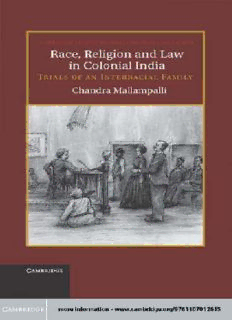
Race, Religion and Law in Colonial India: Trials of an Interracial Family PDF
Preview Race, Religion and Law in Colonial India: Trials of an Interracial Family
Race, Religion, and Law in Colonial India How did British rule in India transform persons from lower social classes? Could Indians from such classes rise in the world by marry- ing Europeans and embracing their religion and customs? This book explores such questions by examining the intriguing story of an inter- racial family who lived in southern India in the mid-nineteenth century. The family, which consisted of two untouchable brothers, both of whom married Eurasian women, became wealthy as distillers in the local community. When one brother died, a dispute arose between his wife and brother over family assets, which resulted in a landmark court case, Abraham v. Abraham. It is this case which is at the center of this book, and which Chandra Mallampalli uses to examine the lives of those involved and, by extension, of those 271 witnesses who testi- fied. In its multilayered approach, the book sheds light not only on interracial marriage, class, religious allegiance, and gender, but also on the British encounter with Indian society. It shows that far from being products of a “civilizing mission” who embraced the ways of Englishmen, the Abrahams were ultimately – when faced with the stric- tures of the colonial legal system – obliged to contend with hierarchy and racial difference. Chandra Mallampalli is Associate Professor of History at Westmont College. His publications include Christians and Public Life in Colonial South India, 1863–1937 (2004). Cambridge Studies in Indian History and Society, No. 19 C. A. Bayly Vere Harmsworth Professor of Imperial and Naval History, University of Cambridge, and Fellow of St Catharine’s College Gordon Johnson President Emiretus, Wolfson College Cambridge Studies in Indian History and Society publishes monographs on the history and anthropology of modern India. In addition to its pri- mary scholarly focus, the series includes work of an interdisciplinary nature, which contributes to contemporary social and cultural debates about Indian history and society. In this way, the series furthers the gen- eral development of historical and anthropological knowledge to attract a wider readership than that concerned with India alone. Other titles in the series C. A. Bayly, Empire and information: intelligence gathering and social communication in India, 1780–1880 Ian Copland, The princes of India in the endgame of empire, 1917–1947 Samita Sen, Women and labour in late colonial India: the Bengal jute industry Sumit Guha, Environment and ethnicity in India from the thirteenth to the twentieth century Tirthankar Roy, Traditional industry in the economy of colonial India Claude Markovits, The global world of Indian merchants, 1750–1947: traders of Sind from Bukhara to Panama Prasannan Parthasarathi, The transition to a colonial economy: weavers, merchants and kings in South India, 1720–1800 Nandini Gooptu, The politics of the urban poor in early twentieth-century India Norbert Peabody, Hindu kingship and polity in pre colonial India Daud Ali, Courtly culture and political life in early medieval India William Gould, Hindu nationalism and the language of politics in late colonial India William R. Pinch, Warrior ascetics and Indian empires Durba Ghosh, Sex and the family in colonial India: the making of empire Robert Travers, Ideology and empire in eighteenth-century India: the British in Bengal Joya Chatterji, The spoils of partition: Bengal and India, 1947–1967 Nile Green, Islam and the Army in Colonial India: Sepoy religion in the service of empire Elizabeth Kolsky, Colonial justice in British India: white violence and the rule of law Justin Jones, Shi‘a Islam in colonial India: religion, community and sectarianism Race, Religion, and Law in Colonial India Trials of an Interracial Family CHaNdRa MaLLaMpaLLI cambridge university press Cambridge, New York, Melbourne, Madrid, Cape Town, Singapore, São Paulo, Delhi, Tokyo, Mexico City Cambridge University Press 32 Avenue of the Americas, New York, NY 10013-2473, USA www.cambridge.org Information on this title: www.cambridge.org/9781107012615 © Chandra Mallampalli 2011 This publication is in copyright. Subject to statutory exception and to the provisions of relevant collective licensing agreements, no reproduction of any part may take place without the written permission of Cambridge University Press. First published 2011 Printed in the United States of America A catalog record for this publication is available from the British Library. Library of Congress Cataloging in Publication data Mallampalli, Chandra, 1965– Race, religion, and law in colonial India : trials of an interracial family / Chandra Mallampalli. p. cm. – (Cambridge studies in Indian history and society) Includes bibliographical references and index. ISBN 978-1-107-01261-5 (hardback) 1. Abraham, Matthew. d.1842 – Trials, litigation, etc. 2. Inheritance and succession – India – Bellary (District) – History – 19th century. 3. Legal polycentricity – India – Bellary (District) – History – 19th century. 4. Bellary (India : District) – Social conditions – 19th century. I. Title. KNS46.A27M35 2011 346.54′87052–dc23 2011022030 ISBN 978-1-107-01261-5 Hardback Cambridge University Press has no responsibility for the persistence or accuracy of URLs for external or third-party Internet Web sites referred to in this publication and does not guarantee that any content on such Web sites is, or will remain, accurate or appropriate. amma-ki Suseela Bendapudi (1934–2009) Contents List of Maps and Figures page xi Acknowledgments xiii Glossary xvii Introduction 1 From Curry Pot to Salad Bowl 10 Chapters 23 1. Remembering Family 25 Bellary’s Bazaar Workers 27 The Early Years 37 Charlotte Fox and the Platchers 42 Conclusion 49 2. Embodying “Dora-hood”: The Brothers and Their Business 51 Acquiring Skill and Wealth 54 The Distillery’s Pedda Dora 61 After Matthew 73 Conclusion 77 3. A Crisis of Trust: Sedition and the Sale of Arms in Kurnool 79 The Siege of Kurnool 81 Matthew’s Kurnool Agency 86 Conclusion 98 4. Letters from Cambridge 100 Situating Charles Henry Abraham 101 Leaving Home 105 In Need of an Ally 114 Charles Responds 120 Conclusion 127 ix
Description: